Incoterms 2010
EXW - Incoterms 2010
EXW – Ex Works … (named place)
Characteristics
Ex works terms makes the seller responsible to place the goods at disposal of the buyer at seller’s facilities or any other named place. EXW terms do not obligate the seller to clear exports or load goods into the collecting vehicle.
With this term, the seller has minimum obligation and buyer must bear all costs and risk involved on pick up and transportation of goods from seller’s premises. This term can have one variation that mentions explicit that seller must clear customs or load goods into the vehicle and its similar to FCA term.
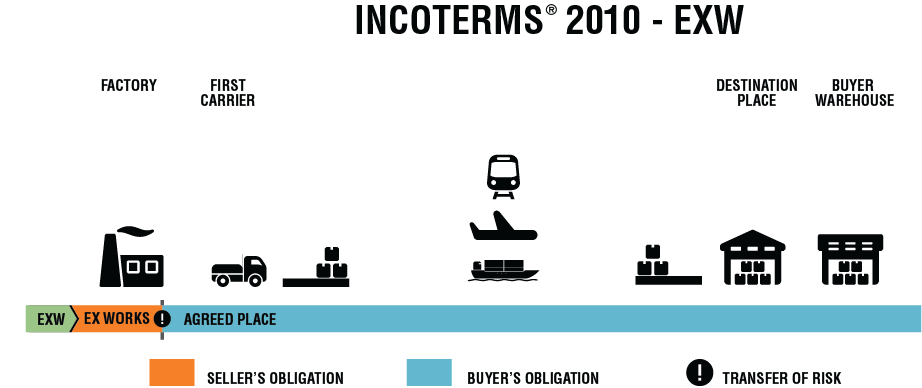
EXW Explained
EXW represents the minimum obligation to the seller and seller’s obligations end when goods are placed at disposal to buyer. Usually, EXW is used when seller does not want to be responsible for movement of goods to other warehouses or ports.
Depending on local practice, seller can load goods into transport vehicle if agreed by mutual parties. Other cases, where buyer wants to avoid additional loading fees, buyer arranges the loading with their own equipment or manually (i.e. loading of goods by hand). If buyer is not able to clear customs on origin, it is recommended to use FCA Place of Receipt.
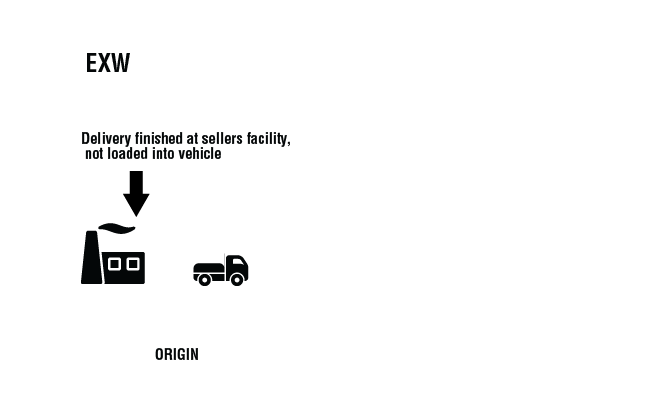
EXW Examples
Buying fruits in Costa Rica:
EXW Finca La Fortuna, Heredia, Costa Rica
Buying goods at free trade zone:
EXW Shanghai Free Trade Zone, Sony Warehouse, China
EXW Seller and Buyer obligations
This is the term with less risk for the seller. Goods are delivered at the agreed place and there is no obligation for the seller to load goods into the vehicle. However, it is common practice to agree on loading at buyer’s expense and risk.
Seller must provide and collaborate with all documentation for export and insurance.
| THE SELLER'S OBLIGATIONS |
THE BUYER'S OBLIGATIONS |
|---|---|
| 1. Provision of goods The seller must deliver the goods, provide commercial invoice or an equivalent electronic document, provide evidence of conformity or proof of delivery |
1. Payment of the price The buyer must pay the price of goods as agreed in the contract of sale |
| 2. Licences, authorisations and formalities The seller must provide export licenses or local authorisations for exporting goods |
2. Licences, authorisations and formalities The buyer must get any export license and import permit for the export of goods |
| 3. Contracts of carriage and insurance Contract of carriage: no obligation Contract of insurance: no obligation |
3. Contracts of carriage and insurance Contract of carriage: no obligation Contract of insurance: no obligation |
| 4. Delivery The seller must place the goods at the named place of delivery. The seller has no obligation to load the goods on any collecting vehicle. The seller must deliver the goods within the period and time agreed.It is good practice to name the location, otherwise the seller can select the best point available |
4. Taking delivery The buyer must take delivery of the goods when they are delivered.In some cases, it is common practice to agreed having the shipper to load goods into the collecting vehicle at buyers expense and risk |
| 5. Transfer of risks The seller is responsible until goods are in place as in the agreed time |
5. Transfer of risk The buyer bear risk and loss or damaged goods from the time goods are in place until the expiry date |
| 6. Division of costs The seller pays all cost until goods are in place for pick up |
6. Division of costs The buyer must pay transportation and additional cost from goods delivery which includes customs formalities at origin |
| 7. Notice to the buyer The seller must inform the buyer when goods will be ready to pick up |
7. Notice to the seller Assuming that seller has informed the buyer about goods ready to be picked up. The buyer must collect goods within the agreed time |
| 8. Proof of delivery, transport document or equivalent electronic message No obligation |
8. Proof of delivery, transport document or equivalent electronic message The buyer must provide the seller with appropriate evidence of having taken delivery. |
| 9. Checking The seller must bear the cost of checking, quality control, measuring, weighing, counting, packing of goods and marking. If special package is required, the buyer must inform and the seller and agreed on extra expenses |
9. Inspection of goods The buyer must bear the cost of pre-shipment and exports inspection except when is mandatory by the government |
| 10. Other obligations The seller must cooperate with all documentation for export and insurance |
10. Other obligations The buyer must pay for all export documentation and insurance |
FCA - Incoterms 2010
FCA – Free Carrier … (Place at Origin)
FCA Characteristics
FCA is the firs of F terms, it means that the seller delivers the goods cleared for export to the nominated carrier at the named place. The buyer must nominate the carrier.
If the place of delivery is at the sellers premises, seller must load the goods. If delivery takes place in a different place, the seller is not responsible for unloading.
The term carrier refers to any party who is in charge of the contract of carriage and will transport the goods by any mode of transportation.
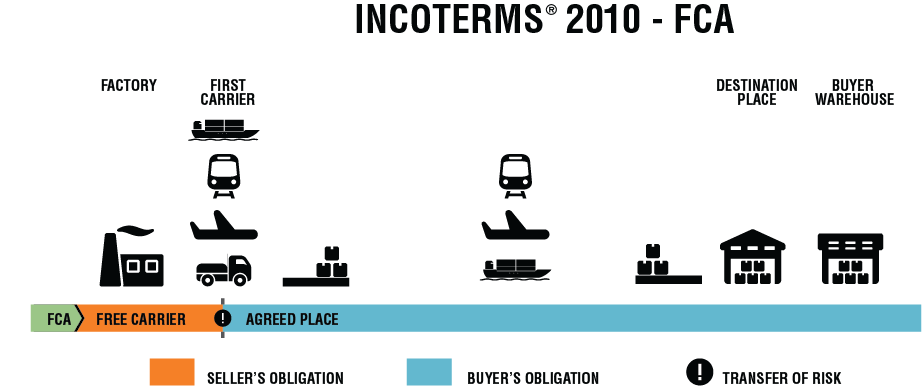
FCA Explained
There can be 3 types of places of receipt when using FCA, sellers facility, freight forwarders facility or port/airport. Seller must load goods into transport vehicle only when place of receipt is sellers facility. In all cases, seller must clear customs for exports and freight and international transport arrangements must be performed by buyer. FCA can be used for any mode of transportation.
FCA is one of the most favourable term when buyer wants to have control of costs at origin and international transportation through a nominated freight forwarder. FCA is commonly used in conjunction with a Forwarders Cargo Receipt (FCR), a document that proves that cargo has been received by a forwarder with the intention to be transported as per buyers conditions. FCR is a proof of delivery and can be used for document compliance instead of Bill of Lading
FCA requires that buyers pays for origin terminal handling charge when cargo is containerize. A “carrier” means any company that has been nominated by the buyer to act as transport agent, meaning that a freight forwarder qualifies as carrier in this case.
It is recommended to use FCA instead of FOB for containerized cargo. In case of FCL, container can be placed at sellers facility. If cargo will be transported as LCL, most cases it is required that seller deliver goods into a nominated warehouse for consolidation.
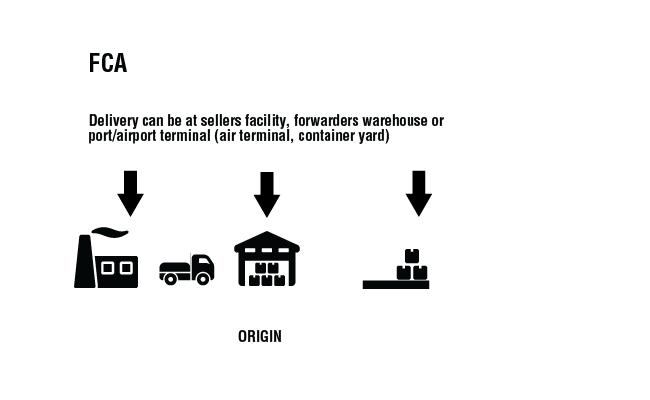
FCA Examples
At sellers facility (shipper must load cargo into container):
FCA ABB - 1133 South Cavalier Drive, Alamo USA
At forwarders facility (buyer pays for unloading cost):
FCA Panalpina World Transport
6/F AZIA Center, 1233 Lujiazui, Ring Road
Pudong New Area, Shanghai 200120, China
At airport:
FCA KLM - Menzies World BV, Brandenburgbaan 2b, 3045 AK Rotterdam
FCA Seller and Buyer obligations
| THE SELLER'S OBLIGATIONS |
THE BUYER'S OBLIGATIONS |
|---|---|
| 1. Provision of goods The seller must: deliver the goods provide commercial invoice or an equivalent electronic document provide evidence of conformity or proof of delivery | 1. Payment The buyer must : pay the price of goods as agreed in the contract of sale |
| 2. Licences, authorisations and formalities The seller must provide export licenses or local authorizations for exporting goods | 2. Licences, authorisations and formalities The buyer must get any export license and import permit for the export of goods |
| 3. Contracts of carriage and insurance Contract of carriage without obligation Contract of insurance without obligation | 3. Contracts of carriage and insurance Contract of carriage without obligation Contract of insurance without obligation |
| 4. Delivery The seller must deliver the goods to the carrier or any party nominated by the buyer at the named place of delivery and within the date agreed. If delivery place is Seller’s premises, then seller must load the goods Other place, then buyer must load the goods If there is not agreed place, then the seller can determine the best location | 4. Taking delivery The buyer must take delivery of the goods when they are delivered. |
| 5. Transfer of risks The seller is responsible until goods are in place as in the agreed time | 5. Transfer of risks The buyer bear risk and loss or damaged goods from the time goods are in place until the expiry date |
| 6. Costs The seller pays all cost until goods are in place for pick up including customs clearance at origin | 6. Costs The buyer must pay transportation and additional cost from goods delivery |
| 7. Notice to the buyer The seller must inform the buyer when goods will be ready to pick up | 7. Notice to the seller Assuming that seller has informed the buyer about goods ready to be picked up. The buyer must collect goods within the agreed time |
| 8. Proof of delivery, transport document or equivalent electronic message The seller must provide the buyer a proof of delivery of goods at buyers expense. The seller must assist with all export documentation and arrangement of transportation by designated carrier | 8. Proof of delivery, transport document or equivalent electronic message The buyer must accept the proof of delivery |
| 9. Checking - packaging – marking The seller must bear the cost of checking, quality control, measuring, weighing, counting, packing of goods and marking. If special package is required, the buyer must inform and the seller and agreed on extra expenses | 9. Inspection The buyer must pay the costs of any pre-shipment inspection except when such inspection is mandated by the authorities of the country of export. |
| 10. Other The seller must timely provide assistance in securing information and documentation required for transportation and final delivery | 10. Other The buyer must pay all costs and charges incurred in obtaining the documents or equivalent electronic messages |
FAS - Incoterms 2010
FAS – Free Alongside Ship … (Port of Shipment)
FAS Characteristics
In FAS the seller clears the goods for export and delivers them alongiside side the vessel at port of origin. This means that the seller is responsible for all cost and risk to the goods up to point of delivery. This terms applies only for ocean or inland waterway ports.
It is recommended to use this term with the precise location a the port, specially in large ports with multiple locations. FAS term is frequently used in the term of sale of bulk commodities like grains or oil. In case the cargo is containerized, it is common to deliver the goods at carrier container yard or terminal (FCA term will fit best in this case).
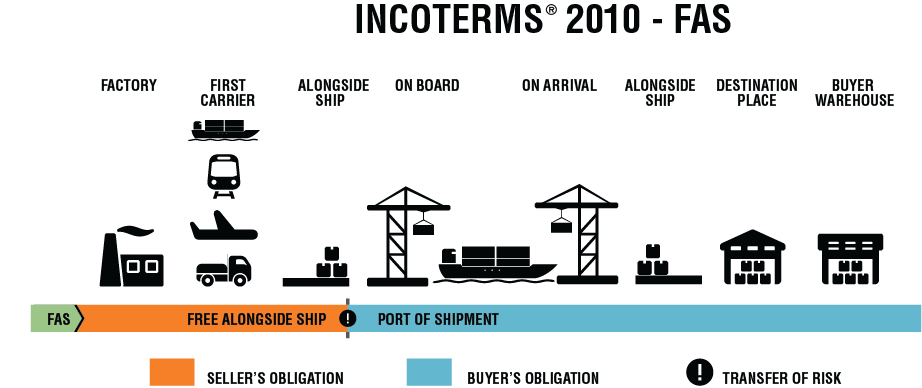
FAS Explained
Seller must deliver goods next to the vessel with export customs clearance paperwork completed. FAS is commonly used for out of gauge (OOG) cargo, which is cargo that cannot fit into internal container dimensions (i.e boats, tractors). FAS can only be used for ocean cargo and loading cost into vessel must be under sellers account.
Because of restricted times available on wharf, time and location are extremely important when negotiating under FAS. This term is also common when buying liquids and ships must deploy hoses for transfer goods (i.e. chemicals).

FAS Examples
Buying a boat with pick up on 10th March before noon:
FAS - Pier 10 Port of Miami Florida
Buying a machine to corrugate boxes in different sets and parts, non-containerised:
FAS - Bremen Pier 2
FAS Seller and Buyer obligations
| A. THE SELLER'S OBLIGATIONS |
B. THE BUYER'S OBLIGATIONS |
|---|---|
| 1. Provision of goods The seller must deliver the goods, provide commercial invoice or an equivalent electronic document, provide evidence of conformity or proof of delivery | 1. Payment The buyer must pay the price of goods as agreed in the contract of sale |
| 2. Licences, authorisations and formalities The seller must provide export licenses or local authorizations for exporting goods | 2. Licences, authorisations and formalities The buyer must get any export license and import permit for the export of goods |
| 3. Contracts of carriage and insurance Contract of carriage without obligation Contract of insurance without obligation | 3. Contracts of carriage and insurance Contract of carriage without obligation Contract of insurance without obligation |
| 4. Delivery The seller must place the goods alongside the ship at named port of loading by the buyer within date and time agreed. | 4. Taking delivery The buyer must take delivery of the goods when they have been delivered |
| 5. Transfer of risks The seller must has to bear all risks of loss of or damage to the goods until such time as they have been delivered alongside the ship | 5. Transfer of risks The buyer must bear all risks of loss of or damage to the goods from the time they have been delivered in accordance. If the vessel is delayed or doesn’t show up as planned, the buyer must afford extra expenses |
| 6. CostsThe seller must pay: All cost to deliver the goods alongside the ship including at origin, customs formalities, duties and taxes and other export charges | 6. Costs The buyer must pay all costs relating to the goods from the time they have been delivered which include loading and insurance, additional cost has been incurred due to vessel delay or no-show, main carriage, import customs, duties and taxes for import until final destination |
| 7. Notice to the buyer The seller must give notice that goods have been delivered alongside ship or the carrier did not took possession of goods as agreed | 7. Notice to the seller The buyer must notify the seller vessel name, loading port and delivery time |
| 8. Proof of delivery, transport document or equivalent electronic message The seller must provide assistance to the buyer on obtaining the transportation document or proof of receipt | 8. Proof of delivery, transport document or equivalent electronic message The buyer must receive proof of delivery by the seller |
| 9. Checking - packaging – marking The seller must pay cost of checking operations, quality control, weighing and counting. appropriated packaging or special packaging upon buyers request and packaging marking | 9. Inspection of goods Unless is mandatory for local authorities, pay for customs inspection at port of loading |
| 10. Other The seller must provide assistance to secure information and documentation for export | 10. Other The buyer must pay for origin documentation to the seller and provide the seller any documentation required for export |
FOB - Incoterms 2010
FOB – Free on Board … (Port of Shipment)
FOB Characteristics
By using FOB the seller clear the goods for exports and delivers when the goods have passed the ship’s rail at the agreed port. This term is only used for water transportation either sea or inland water. If both parties do not agree to have goods delivered on board, then FCA is the term to be used.
This term was commonly used when commodities were sold and carrier confirmed the reception of goods “on board”. When goods are packed in contenerized cargo, then FCA is the most recommended term to use. Because goods will be delivered in the container terminal prior to be loaded on the vessel. The term is used in commodities like oil, bulk cargo or grain. There is a common misuse of this term when goods are loaded on a truck, in that case FCA is the right term to use. In FOB, origin terminal handling charge and all other cost associated to move the goods on board are paid by the seller.
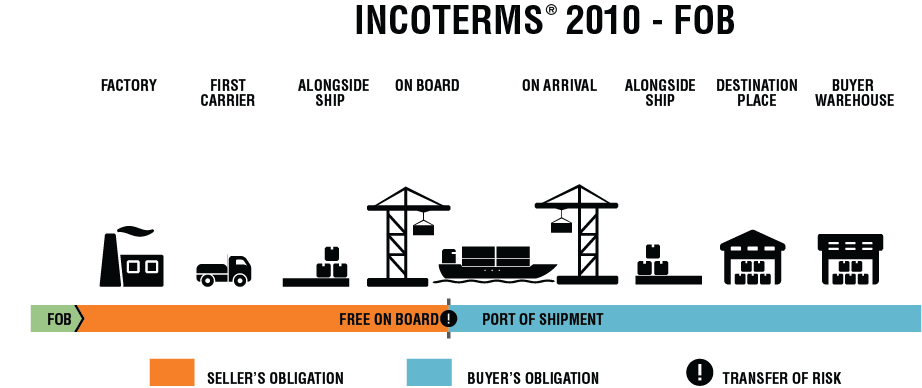
FOB Explained
FOB suits better for bulk cargo and not containerized cargo (use FCA instead). FOB can only be used for ocean transportation, seller’s responsibility ends when goods are placed on board of vessel. All cost after loaded on board must be assumed by buyer.
Export customs clearance and origin terminal handling charge must be assumed by seller. This term is traditionally created for bulk transportation, where some cargo can be lost during the process of loading (i.e. grains taken away by wind or boxes dropped of in the ocean). It is still the most misused term.
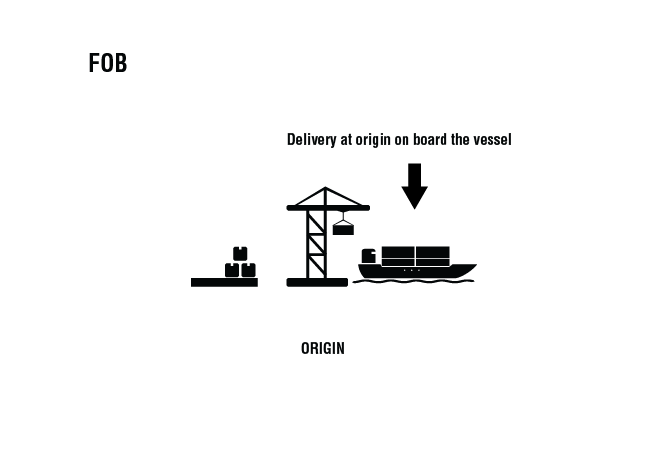
FOB Examples
Buying bulk corn:
FOB Valparaiso port, Chile
Buying bulk potatoes:
FOB Port of Cape Town
FOB Seller and Buyer obligations
| A. THE SELLER'S OBLIGATIONS |
B. THE BUYER'S OBLIGATIONS |
|---|---|
| 1. Provision of goods The seller must deliver the goods, provide commercial invoice or an equivalent electronic document, provide evidence of conformity or proof of delivery | 1. Payment The buyer must pay the price of goods as agreed in the contract of sale |
| 2. Licences, authorisations and formalities The seller must provide export licenses or local authorisations for exporting goods | 2. Licences, authorisations and formalities The buyer must get any export license and import permit for the export of goods |
| 3. Contracts of carriage and insurance Contract of carriage on standard industry terms at buyers risk Contract of insurance without obligation | 3. Contracts of carriage and insurance Contract of carriage at buyers expense at port of origin until final destination Contract of insurance without obligation |
| 4. Delivery The seller must deliver the goods on board on the vessel nominated by the buyer | 4. Taking delivery Take ownership of the goods after loaded into the vessel |
| 5. Transfer of risks The seller is responsible until goods are in place as in the agreed time | 5. Transfer of risks The buyer must assume all risk of loss of damage from the time the goods have been delivered on agreed vessel. If the vessel is delayed or doesn’t show, buyer must pay for additional expenses |
| 6. Costs The seller must pay all cost until the cargo has passed the ship’s rail, including customs, duties and taxes and other port related charges including export customs inspection as per local regulations documentation | 6. Costs The buyer pays from the time the goods passed the ship’s rail, carriage, insurance and import duties and taxes to final destination |
| 7. Notice to the buyer The seller must provide notice of the goods delivered on board at sellers expense | 7. Notice to the seller The buyer must give notice of goods loaded on named vessel at loading point as per agreement |
| 8. Proof of delivery, transport document or equivalent electronic message The seller must deliver at buyer’s expense the proof of delivery on board the ship at the named port of shipment. The seller must assist in obtaining a transport document. EDI communication as proof of delivery is acceptable | 8. Proof of delivery, transport document or equivalent electronic message The buyer must receive the proof of delivery (usually a transportation document like bill of lading or sea way bill of lading) |
| 9. Checking - packaging – marking The seller must bear the cost of checking, quality control, measuring, weighing, counting, packing of goods and marking. If special package is required, the buyer must inform and the seller and agreed on extra expenses | 9. Inspection Unless it’s a mandatory at origin, pay any pre-shipment inspection |
| 10. Other The seller must timely provide assistance in securing information and documentation required for transportation and final delivery | 10. Other The buyer must pay all costs and charges incurred in obtaining the documents or equivalent electronic messages |
CFR - Incoterms 2010
CFR – Cost and Freight … (named port of destination)
CFR Characteristics
In CFR the seller clears goods for exports and delivers when goods are on board. The seller pays for freight to transport the goods until the final port of destination. However, the risk transfer occurs when goods are on board.
This term is used in ocean and inland waterway transportation. The contract must specify the exact port of destination. If shipment is containerized, it is preferred to use CPT. This term is usually applied when goods are in bulk cargo like grains and oil, oversized cargo or cargo that exceeds the normal dimensions to fit inside a container.
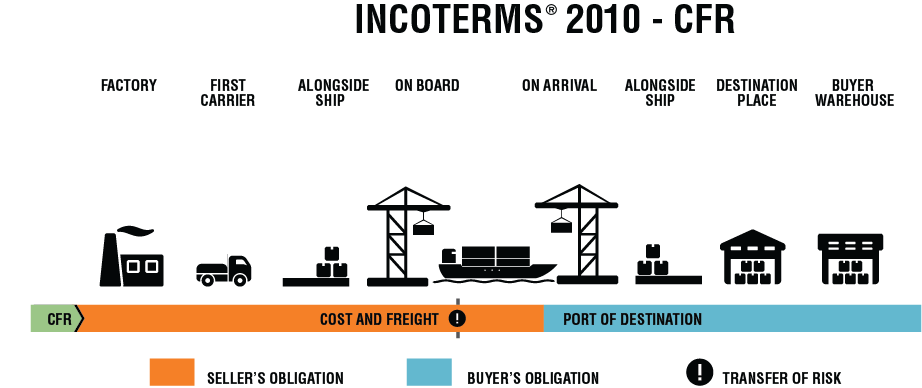
CFR Explained
Deliver happens in the port of loading, risk for seller ends at port of origin. In addition to this, seller must arrange international freight transportation and provide all documentation to buyer. Seller must also clear exports customs. In summary, seller arranges transportation under buyers risk, therefore it is recommended that buyer gets additional insurance coverage.
This term is exclusively used on ocean transportation. This term is commonly used for agricultural or chemical products where seller has expertise and buying power on loading and transportation until port of discharge.
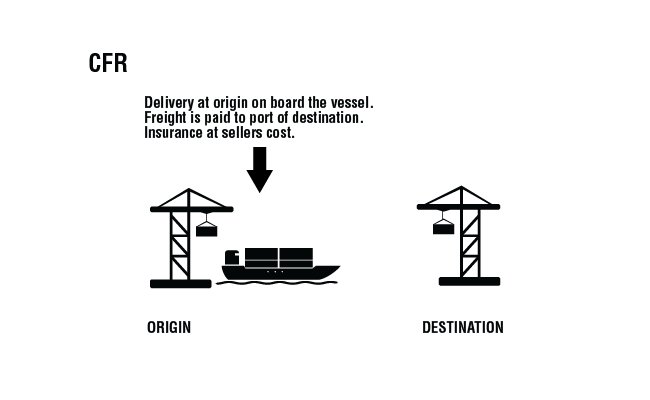
CFR Examples
Buying chemicals from China: CFR Port of Rotterdam
CFR Seller and Buyer obligations
| THE SELLER'S OBLIGATIONS |
THE BUYER'S OBLIGATIONS |
|---|---|
| 1. Provision of goods The seller must deliver the goods, provide commercial invoice, provide evidence of conformity or proof of delivery | 1. Payment The buyer must pay the price of goods as agreed in the contract of sale |
| 2. Licences, authorisations and formalities The seller must provide export licenses or local authorizations for exporting goods. |
2. Licences, authorisations and formalities The buyer must get any export license and import permit for the export of goods |
| 3. Contracts of carriage and insurance Contract of carriage of goods from the point of delivery to the named port of destination. No obligation to provide insurance, but to provide information to buyer to obtain insurance. |
3. Contracts of carriage and insurance Contract of carriage without obligation. Contract of insurance without obligation |
| 4. Delivery The seller must deliver the goods on board the ship |
4. Taking delivery Take delivery of the goods at the agreed port of destination |
| 5 Transfer of risks The seller is responsible until goods passed the rail’s ship |
5 Transfer of risks The buyer must bear all risks of loss of or damage from the time the goods have been delivered on board |
| 6. Costs The seller must pay: All cost until delivery on board, loading cost and carriage until port of destination, all export duties and taxes and customs formalities |
6. Costs The buyer pays for all cost relating since goods are on board, unloading cost unless they are included in the contract of carriage, customs and taxes at destination as well as formalities |
| 7. Notice to the buyer The seller must notify the buyer that goods have been delivered |
7. Notice to the seller The buyer must provide time of shipment and port of destination |
| 8. Proof of delivery, transport document or equivalent electronic message At his own expense, transport documentation with on board date in full set when originals are printed. |
8. Proof of delivery, transport document or equivalent electronic message Accept sellers transportation document in comformity |
| 9. Packing The seller must bear the cost of checking, quality control, measuring, weighing, counting, packing of goods and marking. If special package is required, the buyer must inform and the seller and agreed on extra expenses |
9. Inspection Unless it’s a mandatory at origin, pay any pre-shipment inspection |
| 10. Other Assist obtaining additional information required by the seller |
10. Other Pay all expenses for obtaining additional documents. |
CIF - Incoterms 2010
CIF – Cost, Insurance and Freight paid to … (Port of Destination)
CIF Characteristics
In CIF terms, the seller clears the goods at origin places the cargo on board and pays for insurance until port of discharge at minimum cover. Even though the seller pays for insurance during the main carriage, the risk is transferred to the buyer at time the goods are on board. The term is used for ocean and inland waterway transportation only
This term is commonly used in bulk cargo, oil and oversized.

CIF Explained
Deliver happens in the port of loading, risk for seller ends at port of discharge and must adquire insurance coverage. In addition to this, seller must arrange international freight transportation and provide all documentation to buyer. Seller must also clear exports customs.
This term is exclusively used on ocean transportation. If cargo doesn’t fit into a container, use CIT. This term is commonly used for agricultural or chemical products where seller has expertise and buying power on loading and transportation until port of discharge and capacity to insure goods.
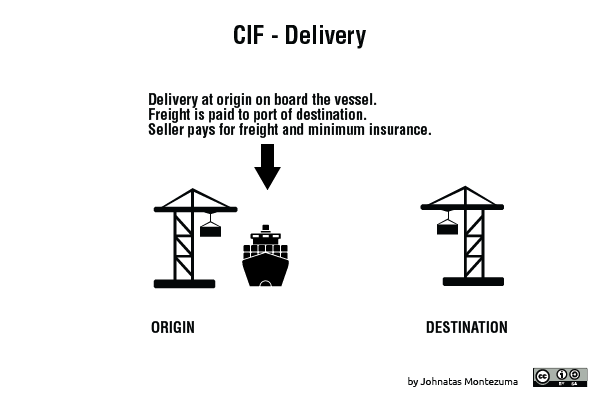
CIF Examples
Buying scrap metal from Thailand (scrap metal also gets insured):
CIF Shanghai Port, China
CIF Seller and Buyer obligations
| THE SELLER'S OBLIGATIONS |
THE BUYER'S OBLIGATIONS |
|---|---|
| 1. Provision of goods The seller must deliver the goods, provide commercial invoice or an equivalent electronic document, provide evidence of conformity or proof of delivery | 1. Payment The buyer must pay the price of goods as agreed in the contract of sale |
| 2. Licences, authorisations and formalities The seller must provide export licenses or local authorizations for exporting goods | 2. Licences, authorisations and formalities The buyer must get any export license for the export of goods |
| 3. Contracts of carriage and insurance The seller must contract on usual terms at his own expense for the carriage of the goods to the named port of destination by the usual route in a seagoing vessel (or inland waterway vessel as the case may be) of the type normally used for the transport of goods of the contract description. Contract of insurance: no obligation | 3. Contracts of carriage and insurance Contract of carriage: no obligation Contract of insurance: no obligation |
| 4. Delivery The seller must deliver the goods on board the ship | 4. Taking delivery Take delivery of the goods at the agreed port of destination |
| 5 Transfer of risks The seller is responsible until goods passed the rail’s ship | 5 Transfer of risks The buyer must bear all risks of loss of or damage from the time the goods have been delivered on board |
| 6. Costs The seller must pay all cost until delivery on board, loading cost and carriage until port of destination, insurance from origin and main carriage and all export duties and taxes and customs formalities | 6. Costs The buyer pays for all cost relating since goods are on board, unloading cost unless they are included in the contract of carriage, customs and taxes at destination as well as formalities |
| 7. Notice to the buyer The seller must notify the buyer that goods have been delivered | 7. Notice to the seller The buyer must provide time of shipment and port of destination |
| 8. Proof of delivery, transport document or equivalent electronic message At his own expense, transport documentation with on board date in full set when originals are printed. | 8. Proof of delivery, transport document or equivalent electronic message Accept sellers transportation document in comformity |
| 9. Checking The seller must bear the cost of checking, quality control, measuring, weighing, counting, packing of goods and marking. If special package is required, the buyer must inform and the seller and agreed on extra expenses | 9. Inspection Unless it’s a mandatory at origin, pay any pre-shipment inspection |
| 10. Other Assist obtaining additional information required by the seller | 10. Other Assist obtaining additional information required by the seller |
CIP - Incoterms 2010
CIP – Carriage and Insurance paid to … (Place of Destination)
CIP Characteristics
Under CIP terms, the seller clears the goods for export and is responsible for deliver the goods at the agreed place of shipment. The seller must pay the cost of carriage, but seller’s risk ends at place of shipment. The seller must procure the minimum insurance until the named place of destination. The buyer has the option to contract additional insurance.
The risk is passed when the goods are received by the first carrier. This term can be used for any mode of transportation.
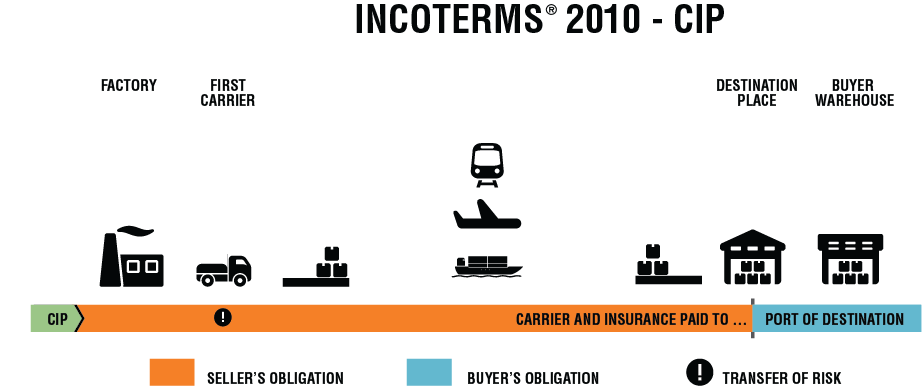
CIP Explained
Seller pays transportation and insurance to destination. Seller pays for minimum insurance which is often acceptable for bulk cargo, but not for manufactured goods or high value merchandise. The seller obtains insurance for buyer’s own risk. Delivery ocurre at origin with first carrier, this means that delivery happens at origin and seller pays for freight until final destination. Seller arranges export clearance and can be used for any mode of transportation.
In case of claims, buyer can claim directly with insurance company. For CIP and CPT, place at destination can be multiple locations. Freight doesn’t have the same cost when delivered at port or at a destination warehouse, additional inland and terminal handling charges will apply. Buyer is responsible for customs clearance. In practice, delays caused at origin which incurs in additional expenses are usually a point of discussion between buyer and seller.
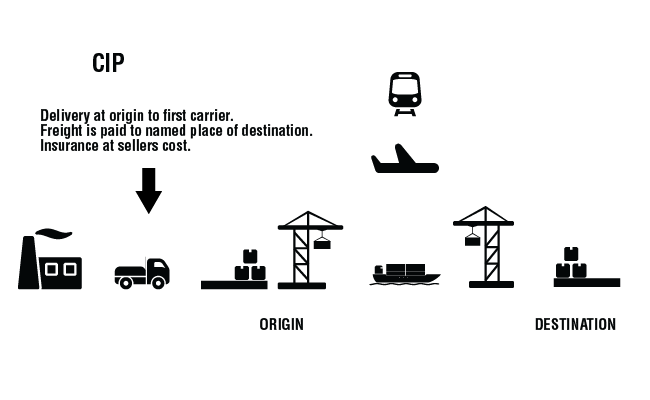
CIP Examples
Mobile phones from Taiwan to Australia:
CIP Keilor Park warehouse of Mobile Distributors, Melbourne, Australia
In this scenario, mobile phones will be shipped by air from Taiwan to Melbourne Airport, after customs clearance, a destination forwarder nominated by seller will transport goods until Mobile Distributor’s warehouse. Destination terminal handling charges at airport and transfers fees at destination airpot are under the account of seller. Seller arranges insurance. Buyer pays for customs clearance and duties.
CIP Seller and Buyer obligations
| THE SELLER'S OBLIGATIONS |
THE BUYER'S OBLIGATIONS |
|---|---|
| 1. Provision of goods in conformity with the contract The seller must deliver the goods, provide commercial invoice or an equivalent electronic document, provide evidence of conformity or proof of delivery | 1. Payment of the price The buyer must pay the price of goods as agreed in the contract of sale |
| 2. Licences, authorisations and formalities The seller must provide export licenses or local authorizations for exporting goods | 2. Licences, authorisations and formalities The buyer must get any export license and import permit for the export of goods |
| 3. Contracts of carriage and insurance Contract of carriage at sellers expense in the usual route Contract of insurance. The seller must obtain at his own expense cargo insurance as agreed in the contract, such that the buyer, or any other person having an insurable interest in the goods, shall be entitled to claim directly from the insurer and provide the buyer with the insurance policy or other evidence of insurance cover. | 3. Contracts of carriage and insurance Contract of carriage: no obligation Contract of insurance: no obligation |
| 4. Delivery The seller must deliver the goods to the first carrier as agreed on named place and time | 4. Taking delivery Take delivery of the goods at the agreed place |
| 5. Transfer of risks The seller is responsible for the goods loss and damaged until the goods have been delivered as agreed | 5. Transfer of risks Assume al risk of loss and damage at the time the goods have been delivered to the first carrier |
| 6. Division of costs The seller pays all cost until goods have been delivered to the first carrier, including loading at place of origin and unloading at place of destination under the agreed contract All export cost, duties and taxes until the agreed point of destination, cost if insurance | 6 Division of costs The buyer pays all cost until goods have been delivered at point of destination, cost and charges while cargo is in transit not included in the contract of carriage, duties and taxes at destination as well as import clearance |
| 7. Notice to the buyer The seller must provide notice of the goods delivered | 7. Notice to the seller The buyer must provide sufficient notice for the goods to be delivered as per agreement |
| 8. Proof of delivery, transport document or equivalent electronic message The seller must provide the usual transport document or electronic message equivalent | 8. Proof of delivery Transport document or equivalent electronic message, accept the transport document as per contract |
| 9. Checking The seller must bear the cost of checking, quality control, measuring, weighing, counting, packing of goods and marking. If special package is required, the buyer must inform and the seller and agreed on extra expenses | 9. Inspection of goods The buyer must bear the cost of pre-shipment and exports inspection except when is mandatory by the government |
| 10. Other obligations The seller must cooperate with all documentation for export and insurance | 10. Other obligations Reimburse the seller for cost related to obtain documentation that buyer requires for customs clearance at destination. |
CPT - Incoterms 2010
CPT – Carriage paid to … (Place of Destination)
CPT - Characteristics
In CPT the seller clears goods for exports and delivers to the nominated carrier at the agreed place of shipment at origin. In this point, the risk is transferred to the seller. The seller is responsible for contracting and paying the main carriage until the agreed named place of destination. The contract of carriage must specify origin and destination. This term can be used for any mode of transportation.
This term is popular in Ro-Ro and airfreight shipments. If there is more than one mode of transportation, the risk is transferred when goods have been delivered to the first carrier.
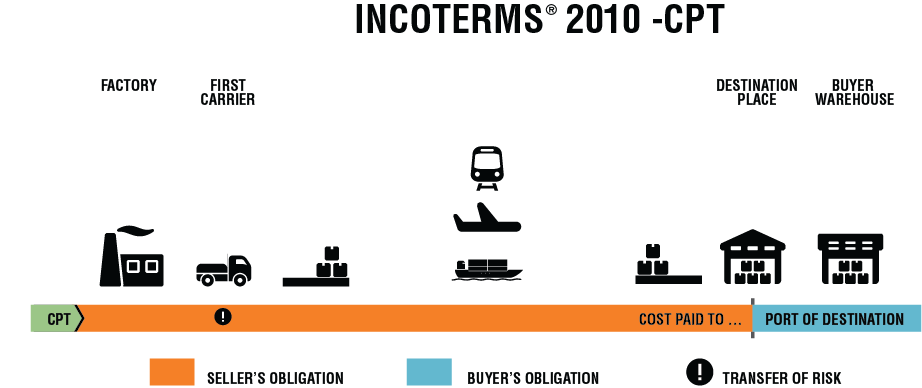
CPT Explained
Similar to CIP, but without insurance paid by seller.
Seller pays transportation to destination. The buyer obtains insurance for his own risk. Delivery ocurre at origin with first carrier, this means that delivery happens at origin and seller pays for freight until final destination. Seller arranges export clearance and can be used for any mode of transportation.
In case of claims, buyer can claim directly with insurance company. For CIP and CPT, place at destination can be multiple locations. Freight doesn’t have the same cost when transported to port of destination or inland destination warehouse, additional inland and terminal handling charges will apply. Buyer is responsible for customs clearance. In practice, delays caused at origin which incurs in additional expenses are usually a point of discussion between buyer and seller.
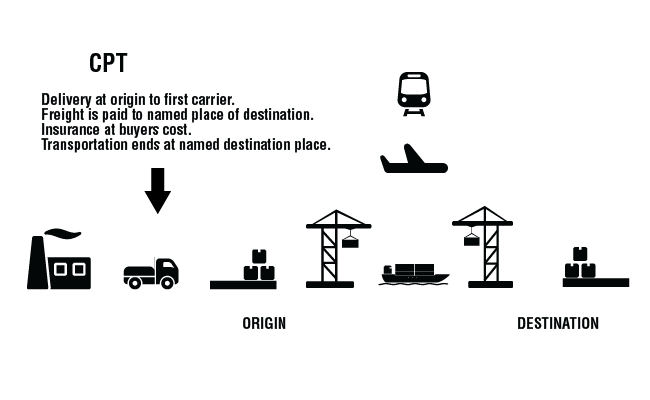
CPT Examples
Monitors from China to Indonesia:
CPT Customer warehouse Jakarta, Indonesia
Seller, a reputable electronics company, sells Monitors to Jakarta via ocean. Seller pays for freight from origin to a warehouse located in Jakarta and unloads goods. Buyer is responsible for insure goods from origin until Jakarta warehouse. In this scenario, even it would be more convenient and easy for buyer to arrange transportation from port of destination to Jakarta warehouse, sellers is in charge of this segment of transportation and expenses via a destination forwarder or a contract of carriage which include all expenses. Additionally, buyer pays for customs clearance plus duties and taxes.
CPT Seller and Buyer obligations
| THE SELLER'S OBLIGATIONS |
THE BUYER'S OBLIGATIONS |
|---|---|
| 1. Provision of goods in conformity with the contract The seller must deliver the goods, provide commercial invoice or an equivalent electronic document, provide evidence of conformity or proof of delivery | 1. Payment of the price The buyer must pay the price of goods as agreed in the contract of sale |
| 2. Licences, authorisations and formalities The seller must provide export licenses or local authorisations for exporting goods | 2. Licences, authorisations and formalities The buyer must get any export license and import permit for the export of goods |
| 3. Contracts of carriage and insurance Contract of carriage at sellers expense in the usual route. No obligation to provide insurance | 3. Contracts of carriage and insurance Contract of carriage: no obligation Contract of insurance: no obligation |
| 4. Delivery The seller must deliver the goods to the first carrier as agreed on named place and time | 4. Taking delivery Take delivery of the goods at the agreed place |
| 5. Transfer of risks The seller is responsible for the goods loss and damaged until the goods have been delivered as agreed | 5. Transfer of risks Assume al risk of loss and damage at the time the goods have been delivered to the first carrier |
| 6. Division of costs The seller pays all cost until goods have been delivered to the first carrier, including loading at place of origin and unloading at place of destination under the agreed contract. All export cost, duties and taxes until the agreed point of destination | 6. Division of costs The buyer pays all cost until goods have been delivered at point of destination. Cost and charges while cargo is in transit not included in the contract of carriage. Duties and taxes at destination as well as import clearance |
| 7. Notice to the buyer The seller must provide notice of the goods delivered | 7. Notice to the seller The buyer must provide sufficient notice for the goods to be delivered as per agreement |
| 8. Proof of delivery, transport document or equivalent electronic message The seller must provide the usual transport document or electronic message equivalent | 8. Proof of delivery, transport document or equivalent electronic message Accept the transport document as per contract |
| 9. Checking The seller must bear the cost of checking, quality control, measuring, weighing, counting, packing of goods and marking. If special package is required, the buyer must inform and the seller and agreed on extra expenses | 9. Inspection of goods The buyer must bear the cost of pre-shipment and exports inspection except when is mandatory by the government |
| 10. Other obligations The seller must cooperate with all documentation for export and insurance | 10. Other obligations Reimburse the seller for cost related to obtain documentation that buyer requires for customs clearance at destination. |
DAP - Incoterms 2010
DAP – Delivery at … (Place of Destination)
DAP Characteristics
In DAP, Delivery at Place, the sellers is responsible for moving the goods from origin until their delivery at the disposal place agreed with the buyer ready for unloading at destination. It is recommended to agree in the point of destination as clear as possible. The seller bears the risk until delivery of goods to the named place and should get a contract of carriage that matches the contract of sell until the agreed delivery point. If there is an extra fee for unloading the goods, the seller cannot charge it to the buyer. This term can be used for any mode of transportation.
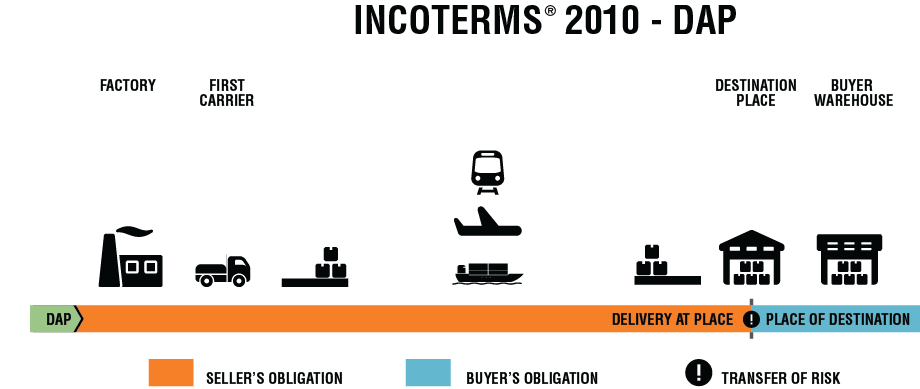
DAP Explained
DAP, deliver from seller ends unloaded at destination place agreed, it can be used for any mode of transportation. Seller pays for export customs, buyer pays for import customs clearance, duties and taxes. Contrary to DAT, goods are delivered unloaded from transport vehicle.
This term minimizes the risk of seller to deliver goods to the first port of entry, unloaded. It is important for seller and buyer to agree on the place of delivery.
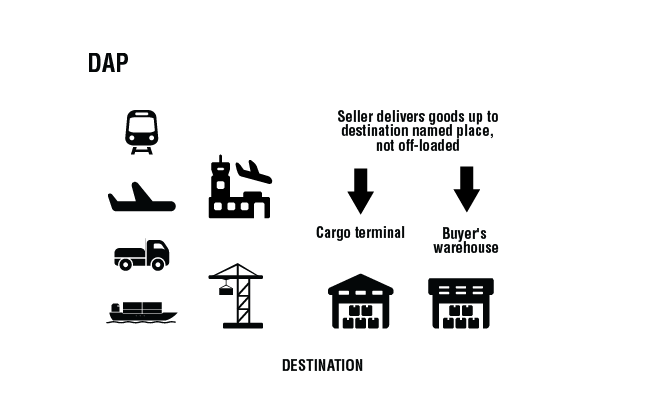
DAP Examples
DAP Patagonia Clothing warehouse, 222 Central Ave, Ventura, CA, USA
DAP Seller and Buyer obligations
| THE SELLER'S OBLIGATIONS |
THE BUYER'S OBLIGATIONS |
|---|---|
| 1. Provision of goods The seller must deliver the goods, provide commercial invoice or an equivalent electronic document, provide evidence of conformity or proof of delivery | 1. Payment The buyer must pay the price of goods as agreed in the contract of sale |
| 2. Licences, authorisations and formalities The seller must provide export licenses or local authorizations for exporting goods | 2. Licences, authorisations and formalities The buyer must get any export license and import permit for the export of goods |
| 3. Contracts of carriage and insurance Contract of carriage at sellers expense in the usual route to the agreed point of delivery | 3. Contracts of carriage and insurance Contract of carriage without obligationContract of insurance without obligation |
| 4. Delivery The seller must deliver the goods not unloaded at the agreed point and time | 4. Taking delivery Take delivery of the goods at the agreed place of destination |
| 5. Transfer of risks The seller is responsible until goods are available as agreed | 5. Transfer of risks The buyer must bear all risks of loss of or damage from the time the goods have been made available in the agreed place of delivery |
| 6. Costs The seller must pay:All cost of main carriage, loading at place of origin, export clearance at origin | 6. Costs The buyer pays forAll cost relating since goods are available, import customs duties and taxes, unloading at place of destination |
| 7. Notice to the buyer The seller must notify the buyer that goods have been delivered | 7. Notice to the seller The buyer must provide time of shipment and port of destination |
| 8. Proof of delivery, transport document or equivalent electronic message At his own expense, a document that allows the buyer to pick up the goods | 8. Proof of delivery, transport document or equivalent electronic message At his own expense, a document that allows the buyer to pick up the goods |
| 9. Checking - packaging – marking The seller must bear the cost of checking, quality control, measuring, weighing, counting, packing of goods and marking. If special package is required, the buyer must inform and the seller and agreed on extra expenses | 9. Inspection Unless it’s a mandatory at origin, pay any pre-shipment inspection |
| 10. Other Assist obtaining additional information required by the seller | 10. Other Assist obtaining additional information required by the seller |
DAT - Incoterms 2010
DAT – Delivery at Terminal … (Place of Destination)
DAT Characteristics
By using DAT, Delivery at Terminal, the seller clears the goods for exports and is responsible until the goods have arrived at named terminal on destination. Terminal can be understood as quay, warehouse, container yard or any road for rail, air or road. The goods must be unloaded and it is important to mention clearly the name of the terminal in detail. This term is used with any mode of transportation.
It is recommended that seller’s contract with their forwarding company mirrors the contract of sale
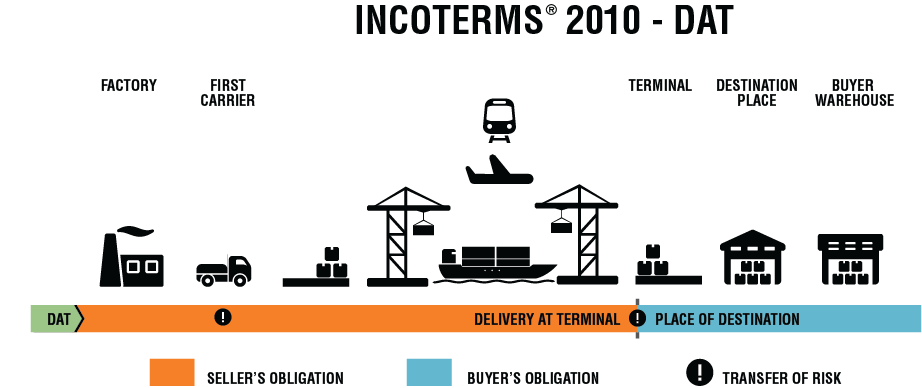
DAT Explained
This term is more specific and used when delivery ends at named terminal on specific port of destination and unloaded. Seller pays all expenses until place of delivery and buyer pays for customs clearance and taxes at destination.
As all D-terms risk and delivery happen at the same time at destination. This term was specifically designed to meet airport and port deliveries. In practice, air cargo which arrives at specific airports are then transported to air terminals and incur in transfer fees and terminal fees from airport to air terminal. For ocean cargo, discharged containers are then moved to specify container yards (CY), where containers are stored while in transit to their final destination. By this means, destination terminal handling charges are under sellers account and buyer only pays for customs clearance, duties and taxes.
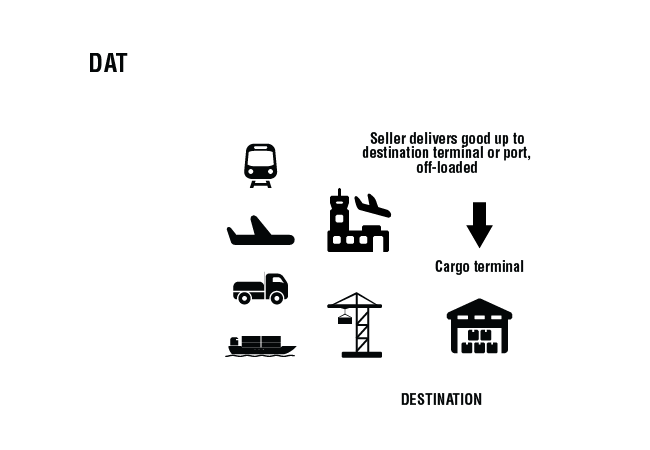
DAT Examples
Ocean Cargo:
DAT Singapore Port, Pier 10, Singapore
Air Cargo:
DAT Swissport terminal, Frankfurt, Germany
DAT Seller and Buyer obligations
| THE SELLER'S OBLIGATIONS |
THE BUYER'S OBLIGATIONS |
|---|---|
| 1. Provision of goods The seller must deliver the goods, provide commercial invoice or an equivalent electronic document, provide evidence of conformity or proof of delivery | 1. Payment The buyer must pay the price of goods as agreed in the contract of sale |
| 2. Licences, authorisations and formalities The seller must provide export licenses or local authorizations for exporting goods | 2. Licences, authorisations and formalities The buyer must get any export license and import permit for the export of goods |
| 3. Contracts of carriage and insurance Contract of carriage at sellers expense in the usual route to the agreed point of delivery | 3. Contracts of carriage and insurance Contract of carriage without obligation Contract of insurance without obligation |
| 4. Delivery The seller must deliver the goods unloaded at the agreed point and time | 4. Taking delivery Take delivery of the goods at the agreed port of destination |
| 5. Transfer of risks The seller is responsible until goods are available as agreed | 5. Transfer of risks The buyer must bear all risks of loss of or damage from the time the goods have been made available in the agreed place of delivery |
| 6. Costs The seller must pay all cost of main carriage, loading at place of origin, export clearance at origin, unloading at place of destination | 6. Costs The buyer pays for all cost relating since goods are available, import customs duties and taxes |
| 7. Notice to the buyer The seller must notify the buyer that goods have been delivered | 7. Notice to the seller The buyer must provide time of shipment and port of destination |
| 8. Proof of delivery, transport document or equivalent electronic message At his own expense, a document that allows the buyer to pick up the goods | 8. Proof of delivery, transport document or equivalent electronic message Accept sellers delivery document |
| 9. Checking The seller must bear the cost of checking, quality control, measuring, weighing, counting, packing of goods and marking. If special package is required, the buyer must inform and the seller and agreed on extra expenses | 9. Inspection Unless it’s a mandatory at origin, pay any pre-shipment inspection |
| 10. Other Assist obtaining additional information required by the seller | 10. Other Assist obtaining additional information required by the seller |
DDP - Incoterms 2010
DDP – Delivery Duty Paid … (Place of Destination)
DDP Characteristics
Under DDU the seller is responsible for all costs associated until the seller delivers the goods to the buyer, cleared for import at named place of destination. In DDP the seller does not pay for unloading the goods. It is important to mention the exact name of the place of destination. This term can be used for any mode of transportation including multimodal. The term is used under the assumption that the seller is capable of clear customs at destination.
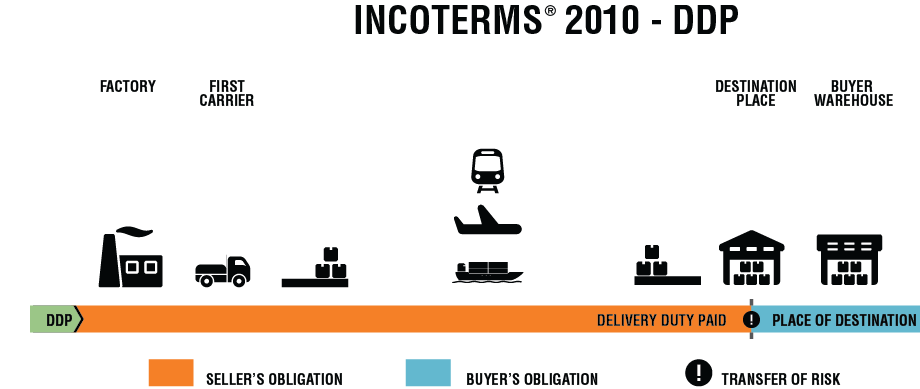
DDP Explained
For this term, seller delivers goods until the final point agreed with buyer with customs import clearance paid and goods unloaded. It represents the maximum risk for seller. Seller must pay all duties, taxes, VAT and other destination charges. It doesn’t require any party for insurance and can be used for any mode of transportation.
In practice, seller must know what to do when selling up to final destination with all expenses covered. It is usually applicable for items like courier where the full supply chain cost is under control and with minimum cost variance.
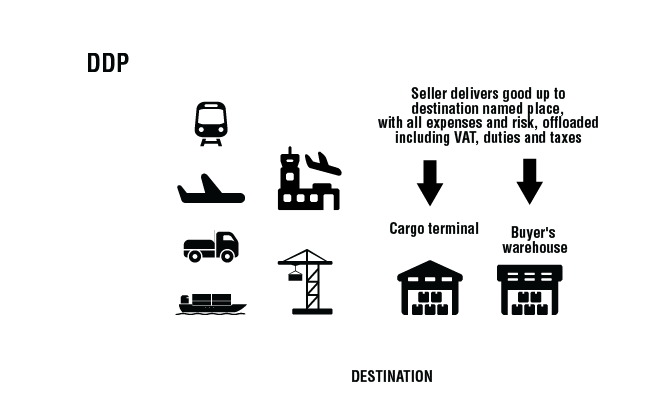
DDP Examples
Courier delivery of online purchases:
DDP 445 Ocean Road, Sydney, Australia
DDP Seller and Buyer obligations
| THE SELLER'S OBLIGATIONS |
THE BUYER'S OBLIGATIONS |
|---|---|
| 1 Provision of goods The seller must deliver the goods, provide commercial invoice or an equivalent electronic document, provide evidence of conformity or proof of delivery | 1 Payment The buyer must, pay the price of goods as agreed in the contract of sale |
| 2 Licences, authorisations and formalities The seller must provide export licenses or local authorizations for exporting goods | 2 Licences, authorisations and formalities The buyer must get any export license and import permit for the export of goods |
| 3 Contracts of carriage and insurance The seller must contract on usual terms at his own expense for the carriage of the goods to the named place of destinationNo obligation for contract insurance | 3 Contracts of carriage and insurance Contract of carriage without obligation Contract of insurance without obligation |
| 4 Delivery The seller deliver the goods in the agreed place of destination at disposal of the buyer or any nominated person by the buyer, does not require to unload the goods | 4 Taking delivery The buyer must pick up the goods once are available |
| 5 Transfer of risks The seller is responsible until are available to the buyer | 5 Transfer of risks The buyer must bear all risks of loss of or damage from the time the goods have been delivered |
| 6 Costs The seller must pay: ll cost until delivery on board, lloading cost and carriage until port of destination, insurance from origin and main carriage, all export duties and taxes and customs formalities, all import duties and taxes and customs formalities | 6 Costs The buyer must pay for unloading cost unless they are included in the contract of carriage |
| 7 Notice to the buyer The seller must notify the buyer that goods have been delivered | 7 Notice to the seller The buyer must notify the delivery time |
| 8 Proof of delivery, transport document or equivalent electronic message At his own expense, transport documentation with on board date in full set when originals are printed. | 8 Proof of deliver Transport document or equivalent electronic messageAccept sellers transportation document in comformity |
| 9 Checking The seller must bear the cost of checking, quality control, measuring, weighing, counting, packing of goods and marking. If special package is required, the buyer must inform and the seller and agreed on extra expenses | 9 Inspection Unless it’s a mandatory at origin, pay any pre-shipment inspection |
| 10 Other Assist obtaining additional information required by the seller | 10 Other Assist obtaining additional information required by the seller |